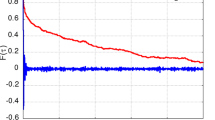Abstract
A systematic study based on the self-consistent dynamical simulations is presented for the grain boundary thermal grooving problem by strictly following the irreversible thermodynamic theory of surfaces and interfaces with singularities [T. O. Ogurtani, J. Chem. Phys. 124, 144706 (2006)]. This approach furnishes us to have auto-control on the otherwise free-motion of the grain boundary triple junction without presuming any equilibrium dihedral (wetting) angles at the edges. The effects of physicochemical properties and the anisotropic surface diffusivity on the transient grooving behavior, which takes place at the early stage of the scenario, were considered. We analyzed the experimental thermal grooving data reported for tungsten in the literature, and compared them with the carried simulation results. This investigation showed that the observed changes in the dihedral angles are strictly connected to the transient behavior of the simulated global system, and manifest themselves at the early stage of the thermal grooving phenomenon.









Similar content being viewed by others
Abbreviations
- GB:
-
Grain boundary
- TJ:
-
Triple junction
- AFM:
-
Atomic force microscopy
- WP:
-
Wetting parameter
- BC:
-
Boundary conditions
References
Tritscher P, Broadbridge P (1995) Proc R Soc Lond A 450:569
Mullins WW (1957) J Appl Phys 28:333
Gibbs W (1948) Thermodynamics, vol I. Yale University Press, New Haven
Murr LE (1975) Interfacial phenomena in metals and alloys. Addison-Wesley, Massachusetts
Young T (1805) Philos Trans R Soc Lond 95:65
Rabkin E, Klinger L, Semenov V (2000) Acta Mater 48:1533
Klinger L, Rabkin E (2001) Interface Sci 9:55
Xin T, Wong H (2003) Acta Mater 51:2305
Zhang W, Sachenko PP, Gladwell I (2004) Acta Mater 52:107
Klinger LM, Chu X, Mullins WW, Bauer CL (1996) J Appl Phys 80:6670
Nathan M, Glickman EE, Khenner M, Averbuch A, Israeli M (2000) Appl Phys Lett 77:3355
Khenner M, Averbuch A, Israeli M, Nathan M, Glickman EE (2001) Comput Mater Sci 20:235
Liu CY, Lee S, Chuang TJ (2001) Mater Sci Eng B Solid 86:101
Wang WL, Lee S, Chuang TJ (2002) Philos Mag A 82:955
Chuang TJ, Rice JR (1973) Acta Metall 21:1625
Pharr G, Nix WD (1979) Acta Metall 27:1615
Martinez L, Nix WD (1982) Metall Trans A 13:427
Igic P, Mawby PA (1999) Solid State Electron 43:255
Ogurtani TO (2006) J Chem Phys 124:144706
Ogurtani TO, Oren EE (2005) Int J Solids Struct 42:3918
Ogurtani TO (2006) Phys Rev B 73:235408
Oren EE, Ogurtani TO (2002) In: Ozkan CS, Cammaratai RC, Freund LB, Gao H (eds) Thin films: stresses and mechanical properties IX, MRS symposia proceedings No. 695. Materials Research Society, Pittsburgh
Ogurtani TO, Akyildiz O (2005) J Appl Phys 97:093520
Ogurtani TO, Akyildiz O, Oren EE (2008) J Appl Phys 104(1):013518
Ogurtani TO, Akyildiz O (2008) Int J Solids Struct 45:921
Zhang W, Sachenko PP, Schneibel JH (2002) J Mater Res 17:1495
Yeremin EN (1979) The foundations of chemical kinetics. MIR Publishers, Moscow
Ramasubramaniam A, Shenoy VB (2005) Acta Mater 53:2943
Shewmon PG (1966) In: Margolin H (ed) Recrystallization, grain growth and textures. American Society for Metals, Metals Park, Ohio
Hirth JP, Lothe J (1968) Theory of dislocations. McGraw-Hill, New York
Smith U, Kristensen N, Ericson F, Schweitz J (1991) J Vac Sci Technol A 9:2527
Chen N, Li Z, Wang H, Sun J (2007) J Appl Phys 101:033535
Ogurtani TO (2009) J Cryst Growth 311:1584
Gao H (1991) Int J Solids Struct 28:703
Binh V, Chaudier M, Couturier J, Uzan R, Drechsler M (1976) Surf Sci 57:184
Robertson WM (1971) J Appl Phys 42:463
Zhang W, Schneibel JH (1995) Comput Mater Sci 3:347
Sachenko PP, Schneibel JH, Swadener JG, Zhang W (2000) Philos Mag Lett 80:627
Gjostein NA (1963) In: Robertson WD, Gjostein NA (eds) Metal surfaces: structure, energetics and kinetics. American Society for Metals, Metals Park, Ohio
Ogurtani TO (2007) J Appl Phys 102:063517
Prigogine I (1961) Thermodynamics of irreversible processes. Interscience Publisher, New York
Acknowledgements
Thanks are due Dr. Aytac Celik of METU for his valuable comments on the article. We also thank the anonymous reviewer, who pointed out the critical role played by the angular averaging procedure in obtaining the effective isotropic failure time for comparison. This work was partially supported by the Turkish Scientific and Technological Research Council, TUBITAK through a research Grant No.107M011.
Author information
Authors and Affiliations
Corresponding author
Rights and permissions
About this article
Cite this article
Akyildiz, O., Oren, E.E. & Ogurtani, T.O. Mesoscopic nonequilibrium thermodynamics treatment of the grain boundary thermal grooving induced by the anisotropic surface drift diffusion. J Mater Sci 46, 6054–6064 (2011). https://doi.org/10.1007/s10853-011-5567-8
Received:
Accepted:
Published:
Issue Date:
DOI: https://doi.org/10.1007/s10853-011-5567-8



